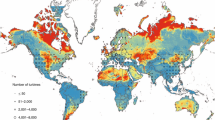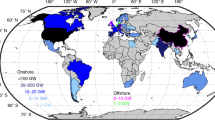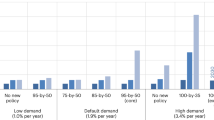Abstract
Optimal wind farm locations require a strong and reliable wind resource and access to transmission lines. As onshore and offshore wind energy grows, preferred locations become saturated with numerous wind farms. An upwind wind farm generates ‘wake effects’ (decreases in downwind wind speeds) that undermine a downwind wind farm’s power generation and revenues. Here we use a diverse set of analysis tools from the atmospheric science, economic and legal communities to assess costs and consequences of these wake effects, focusing on a West Texas case study. We show that although wake effects vary with atmospheric conditions, they are discernible in monthly power production. In stably stratified atmospheric conditions, wakes can extend 50+ km downwind, resulting in economic losses of several million dollars over six years for our case study. However, our investigation of the legal literature shows no legal guidance for protecting existing wind farms from such significant impacts.
This is a preview of subscription content, access via your institution
Access options
Access Nature and 54 other Nature Portfolio journals
Get Nature+, our best-value online-access subscription
$29.99 / 30 days
cancel any time
Subscribe to this journal
Receive 12 digital issues and online access to articles
$119.00 per year
only $9.92 per issue
Buy this article
- Purchase on Springer Link
- Instant access to full article PDF
Prices may be subject to local taxes which are calculated during checkout





Similar content being viewed by others
Data availability
The data that support all of the empirical findings in this study are based on publicly available data as referenced herein. National Weather Service Automated Surface Observing System data were accessed via http://mesonet.agron.iastate.edu/ASOS/. The WRF simulations employ the publicly available WRF code (http://www.wrf-model.org) with no custom code. The data that support the plots within this paper are available at https://github.com/julielundquist/NatureEnergyWindFarmWakes. These data, as well as the namelists for the WRF simulations, are also archived at the University of Colorado PetaLibrary (funded by the NSF under grant OCI-1126839) and can be obtained from the corresponding author upon request.
Change history
05 March 2019
An amendment to this paper has been published and can be accessed via a link at the top of the paper.
References
Electricity in the United States - Energy Explained, Your Guide To Understanding Energy (EIA, 2017); https://www.eia.gov/energyexplained/index.cfm?page=electricity_in_the_united_states
Stokes, L. C. & Warshaw, C. Renewable energy policy design and framing influence public support in the United States. Nat. Energy 2, 17107 (2017).
Brower, M. Wind Resource Assessment: A Practical Guide to Developing a Wind Project (John Wiley & Sons, Hoboken, 2012).
Kaffine, D. T. & Worley, C. M. The windy commons? Environ. Resour. Econ. 47, 151–172 (2010).
Nygaard, N. G. Wakes in very large wind farms and the effect of neighbouring wind farms. J. Phys. Conf. Ser. 524, 12162 (2014).
Davidson, M. R., Zhang, D., Xiong, W., Zhang, X. & Karplus, V. J. Modelling the potential for wind energy integration on China’s coal-heavy electricity grid. Nat. Energy 1, 16086 (2016).
Platis, A. et al. First in situ evidence of wakes in the far field behind offshore wind farms. Sci. Rep. 8, 2163 (2018).
Lissaman, P. B. S. Energy effectiveness of arbitrary arrays of wind turbines. J. Energy 3, 323–328 (1979).
Christiansen, M. B. & Hasager, C. B. Wake effects of large offshore wind farms identified from satellite SAR. Remote Sens. Environ. 98, 251–268 (2005).
Zhou, L. et al. Impacts of wind farms on land surface temperature. Nat. Clim. Change 2, 539–543 (2012).
Rajewski, D. A. et al. Crop wind energy experiment (CWEX): observations of surface-layer, boundary layer, and mesoscale interactions with a wind farm. Bull. Am. Meteorol. Soc. 94, 655–672 (2013).
Rajewski, D. A. et al. Changes in fluxes of heat, H2O, and CO2 caused by a large wind farm. Agric. For. Meteorol. 194, 175–187 (2014).
Armstrong, A. et al. Ground-level climate at a peatland wind farm in Scotland is affected by wind turbine operation. Environ. Res. Lett. 11, 44024 (2016).
Vautard, R. et al. Regional climate model simulations indicate limited climatic impacts by operational and planned European wind farms. Nat. Commun. 5, 3196 (2014).
Jacobson, M. Z., Archer, C. L. & Kempton, W. Taming hurricanes with arrays of offshore wind turbines. Nat. Clim. Change 4, 195–200 (2014).
Jacobson, M. Z. & Archer, C. L. Saturation wind power potential and its implications for wind energy. Proc. Natl Acad. Sci. USA 109, 15679–15684 (2012).
Barthelmie, R. J. et al. Quantifying the impact of wind turbine wakes on power output at offshore wind farms. J. Atmospheric Ocean. Technol. 27, 1302–1317 (2010).
Hansen, K. S., Barthelmie, R. J., Jensen, L. E. & Sommer, A. The impact of turbulence intensity and atmospheric stability on power deficits due to wind turbine wakes at Horns Rev wind farm. Wind Energy 15, 183–196 (2012).
Lee, J. C. Y. & Lundquist, J. K. Evaluation of the wind farm parameterization in the Weather Research and Forecasting model (version 3.8.1) with meteorological and turbine power data. Geosci. Model Dev. 10, 4229–4244 (2017).
Fitch, A. C. et al. Local and mesoscale impacts of wind farms as parameterized in a mesoscale NWP model. Mon. Weather Rev. 140, 3017–3038 (2012).
Fitch, A. C., Lundquist, J. K. & Olson, J. B. Mesoscale influences of wind farms throughout a diurnal cycle. Mon. Weather Rev. 141, 2173–2198 (2013).
Fitch, A. C. Notes on using the mesoscale wind farm parameterization of Fitch et al. (2012) in WRF. Wind Energy 19, 1757–1758 (2015).
Lee, J. C. Y. & Lundquist, J. K. Observing and simulating wind-turbine wakes during the evening transition. Bound.-Layer Meteorol. 164, 449–474 (2017).
Jiménez, P. A., Navarro, J., Palomares, A. M. & Dudhia, J. Mesoscale modeling of offshore wind turbine wakes at the wind farm resolving scale: a composite-based analysis with the Weather Research and Forecasting model over Horns Rev: Mesoscale modeling at the wind farm resolving scale. Wind Energy 18, 559–566 (2015).
DuVivier, K. K. & Witt, T. NIMBY to NOPE—or YESS? Cardozo Law Rev. 38, 1453–1504 (2017).
AWEA State Fact Sheet (AWEA, 2018); http://awea.files.cms-plus.com/FileDownloads/pdfs/Texas.pdf
Annual Electric Utility Data – EIA-923 Data File (EIA, 2017); https://www.eia.gov/electricity/data/eia923/
Annual Electric Generator data – EIA-860 Data File (EIA, 2017); https://www.eia.gov/electricity/data/eia860/
USGS Energy Resources Program (USGS, 2017); https://eerscmap.usgs.gov/uswtdb/viewer/#3/37.25/-96.25
Climate Data Online (NCDC, accessed 31 October 2017); https://www.ncdc.noaa.gov/cdo-web/
Skamarock, W. C. et al. A Description of the Advanced Research WRF version 2. 113 (National Center For Atmospheric Research Boulder Co. Mesoscale and Microscale Meteorology Div., 2008).
Powers, J. G. et al. The Weather Research and Forecasting Model: overview, system efforts, and future directions. Bull. Am. Meteorol. Soc. 98, 1717–1737 (2017).
Schmitz, S. XTurb-PSU: A Wind Turbine Design and Analysis Tool (Penn State University, 2012).
Schroeder, J. L. et al. The West Texas Mesonet: a technical overview. J. Atmospheric Ocean. Technol. 22, 211–222 (2005).
Market Prices (ERCOT, accessed 31 October 2017); http://www.ercot.com/mktinfo/prices
Renewable Electricity Production Tax Credit (PTC) (Department of Energy, accessed 26 May 2018); https://www.energy.gov/savings/renewable-electricity-production-tax-credit-ptc
Kaffine, D. T., McBee, B. J. & Lieskovsky, J. Emissions savings from wind power generation in Texas. Energy J. 34, 155–175 (2013).
Novan, K. Valuing the wind: renewable energy policies and air pollution avoided. Am. Econ. J. Econ. Policy 7, 291–326 (2015).
Millstein, D., Wiser, R., Bolinger, M. & Barbose, G. The climate and air-quality benefits of wind and solar power in the United States. Nat. Energy 2, 17134 (2017).
Tonko, P. H.R. 3165 - 111th Congress (2009–2010): Wind Energy Research and Development Act of 2009 (2009).
Tonko, P. H.R. 2782 - 112th Congress (2011–2012): Wind Energy Research and Development Act of 2011 (2011).
Wind Siting Act 216F (Minnesota Legislature, 1995).
In the Matter of Establishment of General Permit Standards for the Siting of Wind Generation Projects Less than 25 Megawatts (Minnesota Public Utilities Commission, 2008).
Wiser, R. & Bolinger, M. 2016 Wind Technologies Market Report (2018).
Hasager, C. et al. Using Satellite SAR to characterize the wind flow around offshore wind farms. Energies 8, 5413–5439 (2015).
Siedersleben, S. K. et al. Evaluation of a wind farm parametrization for mesoscale atmospheric flow models with aircraft measurements. Meteorol. Zeitschrift. https://doi.org/10.1127/metz/2018/0900 (2018).
Diamond, K. & Crivella, E. Wind turbine wakes, wake effect impacts, and wind leases: using solar access laws as the model for capitalizing on wind rights during the evolution of wind policy standards. Duke Environ. Law Policy Forum 22, 195–244 (2011).
Lee, J. C. Y. & Lundquist, J. K. Evaluation of the wind farm parameterization in the Weather Research and Forecasting model (version 3.8.1) with meteorological and turbine power data. Geosci. Model Dev. Discuss. 2017, 1–31 (2017).
Dee, D. P. et al. The ERA-Interim reanalysis: configuration and performance of the data assimilation system. Q. J. R. Meteorol. Soc. 137, 553–597 (2011).
Hong, S.-Y., Dudhia, J. & Chen, S.-H. A revised approach to ice microphysical processes for the bulk parameterization of clouds and precipitation. Mon. Weather Rev. 132, 103–120 (2004).
Mlawer, E. J., Taubman, S. J., Brown, P. D., Iacono, M. J. & Clough, S. A. Radiative transfer for inhomogeneous atmospheres: RRTM, a validated correlated-k model for the longwave. J. Geophys. Res. D 102, 16663–16682 (1997).
Dudhia, J. Numerical study of convection observed during the winter monsoon experiment using a mesoscale two-dimensional model. J. Atmospheric Sci. 46, 3077–3107 (1988).
Jiménez, P. A. et al. A revised scheme for the WRF surface layer formulation. Mon. Weather Rev. 140, 898–918 (2012).
Ek, M. B. et al. Implementation of Noah land surface model advances in the National Centers for Environmental Prediction operational mesoscale Eta model. J. Geophys. Res. 108, 8851 (2003).
Nakanishi, M. & Niino, H. An improved Mellor–Yamada level-3 model: its numerical stability and application to a regional prediction of advection fog. Bound. Layer Meteorol. 119, 397–407 (2006).
Kain, J. S. The Kain–Fritsch convective parameterization: an update. J. Appl. Meteorol. 43, 170–181 (2004).
Vanderwende, B. J., Kosović, B., Lundquist, J. K. & Mirocha, J. D. Simulating effects of a wind-turbine array using LES and RANS. J. Adv. Model. Earth Syst. 8, 1376–1390 (2016).
State Legislative Approaches to Wind Energy Facility Siting (National Council of State Legislatures, 10 February 2018); http://www.ncsl.org/research/energy/state-wind-energy-siting.aspx
Wind Energy & Wind Park Siting and Zoning Best Practices and Guidance for States 182 (National Regulatory Research Institute, NARUC, 2012).
State Enabling Legislation for Commercial-Scale Wind Power Siting and the Local Government Role 70 (ELI, 2011).
Smith, E. E., DeWolf, S. K. & Wetsel, R. E. Wind Law (LexisNexis, 2017).
DuVivier, K. K. Animal, vegetable, mineral - wind? The severed wind power rights conundrum. Washburn Law J. 49, 69–100 (2009).
Rule, T. A. A downwind view of the cathedral: using rule four to allocate wind rights. San. Diego. Law. Rev. 46, 207–247 (2009).
Rule, T. A. Airspace in a green economy. UCLA Law Rev. 59, 270–332 (2011).
DuVivier, K. K. Sins of the Father. 1 Tex. AM J. Real Prop. Law 1, 391–423 (2014).
DuVivier, K. K. The superagency solution. McGeorge Law Rev. 46, 189–214 (2015).
DuVivier, K. K. Wind power growing pains. Chapman Nexus J. Law Policy 21, 11 (2016).
Diamond, K. Wake effects, wind rights, and wind turbines: why science, constitutional rights, and public policy issues play a crucial role. William Mary Environ. Law Policy Rev. 40, 813 (2016).
Environmental Impacts of Wind-Energy Projects (National Research Council, 2007); https://doi.org/10.17226/11935
Rule, T. A. Solar, Wind and Land: Conflicts in Renewable Energy Development (Routledge, Abingdon, 2014).
Acknowledgements
The views expressed in the article do not necessarily represent the views of the US Department of Energy or the US government. The authors express great appreciation to the National Science Foundation’s (NSF’s) Coupled Natural and Human systems programme, which primarily funded this work under BCS-1413980. J.M.T. was partially supported by an NSF Graduate Research Fellowship under grant number 1144083. Simulations were conducted using the Extreme Science and Engineering Discovery Environment, which is supported by NSF grant number ACI1053575. K. King provided research assistance on the econometric model. We express appreciation to the West Texas Mesonet, Texas Tech University, for the use of the sodar data for the WRF model validation. K.K.D. was supported in her research efforts by D. Burkhardt, T. Witt, S. Lloyd, E. Montague, J. Calicchio, J. Dake, C. Wilden and B. Roche. She also benefitted from consultations with K. Diamond, R. Wetsel, T. Rule, E. Crivella, M. Safty, Y. Lifshitz and B. Diffen. The Alliance for Sustainable Energy, LLC (Alliance) is the manager and operator of the National Renewable Energy Laboratory. The National Renewable Energy Laboratory is a national laboratory of the US Department of Energy, Office of Energy Efficiency and Renewable Energy. This work was authored by the Alliance and supported by the US Department of Energy under contract no. DE-AC36-08GO28308. Funding was provided by the Wind Energy Technologies Office.
Author information
Authors and Affiliations
Contributions
J.K.L., D.K. and K.K.D. conceived the research. D.K. designed and carried out the econometric study and wrote the economic sections. J.K.L. and J.M.T. designed the atmospheric simulations; J.M.T. carried out the atmospheric simulations; J.K.L. and J.M.T. wrote the atmospheric sections. K.K.D. designed the legal investigation and wrote the legal sections. All authors contributed significantly to writing the joint sections.
Corresponding author
Ethics declarations
Competing interests
The authors declare no competing interests.
Additional information
Publisher’s note: Springer Nature remains neutral with regard to jurisdictional claims in published maps and institutional affiliations.
Supplementary information
Supplementary Information
Supplementary Notes 1–7, Supplementary Figures 1–13, Supplementary Tables 1–8, Supplementary References
Rights and permissions
About this article
Cite this article
Lundquist, J.K., DuVivier, K.K., Kaffine, D. et al. Costs and consequences of wind turbine wake effects arising from uncoordinated wind energy development. Nat Energy 4, 26–34 (2019). https://doi.org/10.1038/s41560-018-0281-2
Received:
Accepted:
Published:
Issue Date:
DOI: https://doi.org/10.1038/s41560-018-0281-2
This article is cited by
-
Artificial intelligence-aided wind plant optimization for nationwide evaluation of land use and economic benefits of wake steering
Nature Energy (2024)
-
Larger wind turbines as a solution to reduce environmental impacts
Scientific Reports (2024)
-
Optimal blade pitch control for enhanced vertical-axis wind turbine performance
Nature Communications (2024)
-
Wind power deployment and the impact of spatial planning policies
Environmental and Resource Economics (2024)
-
Improving the Representation of Climate Risks in Long-Term Electricity Systems Planning: a Critical Review
Current Sustainable/Renewable Energy Reports (2023)



